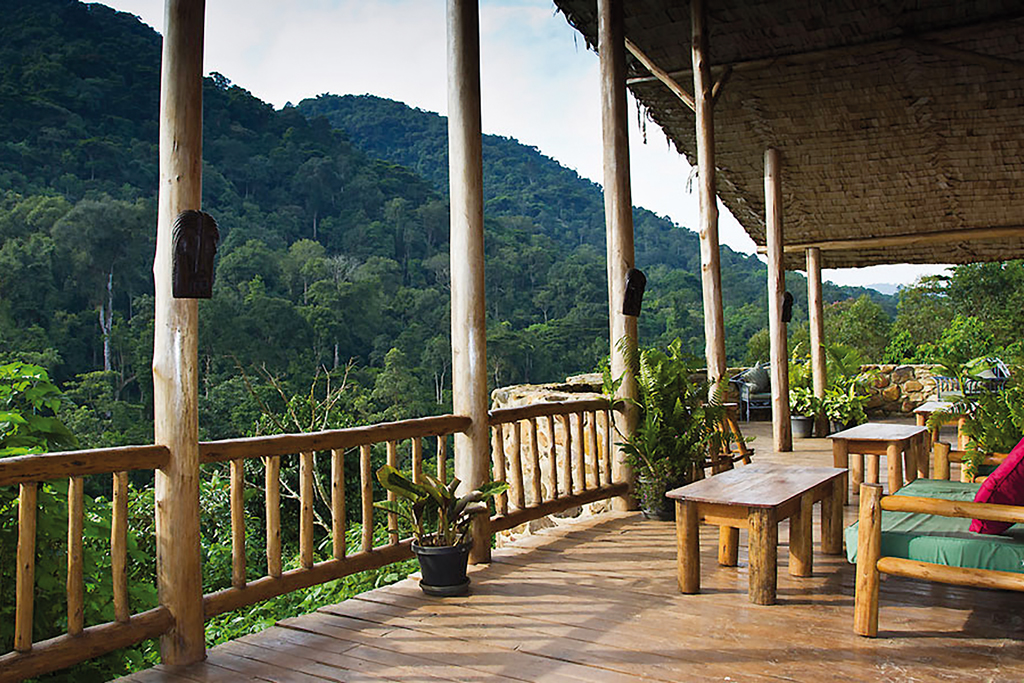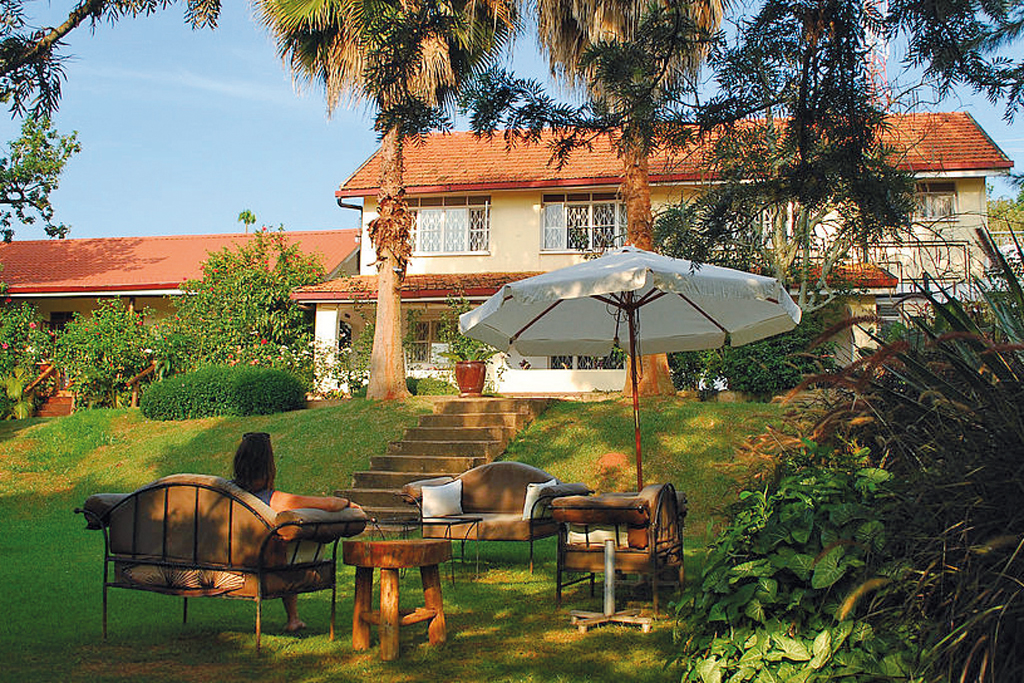Escape to Uganda
Elephants never forget
This post may contain affiliate links. Learn more
Caroline Phillips heads to Uganda to hike Mount Elgon and learns some fascinating quadruped facts along the way.
Trek for Elephants
We’re going to search for cave elephants – the elusive quadruped Babars found ‘tusking’ salt off cave walls. There’s just basic camping on offer. And malaria and yellow fever aren’t a lure either. But I’m a mahout manqué and will do (almost) anything to see elephants. Even hike for four days from a little-explored part of Uganda to Kenya. That’s why my 22-year-old daughter Anya and I are being driven 165 miles from Entebbe to Mount Elgon in Eastern Uganda. Past Lake Victoria, egrets and bamboo forests. When we reach Mbale our driver, Innocent, takes us to the town’s supermarket. Here, among shoppers in tribal prints and a security guard fiddling with an old rifle, we find expedition snacks of plantain crisps and fried corn.
Next we head to nearby Mount Elgon Hotel. I want to stay here forever – not only for its panoramic view of the extinct shield volcano, Mount Elgon, but also because it’s our final comfy night. Yet we’re still up as early as mountain buzzards (5am) to drive 45 minutes to the Mount Elgon National Park office to sign in for our Sasa Trail hike. Here we learn some elephantastic facts. ‘If you annoy an elephant, out of 100 people it will single you out 30 years later,’ explains Peter, the warden. ‘Elephants can smell from a mile away. They’ll break into a bar. They love anything that ferments.’
Local Cuisine and Local Charm
Oh and we learn (boring but important) that the National Park covers 494 square miles, 65 in Kenya; that Mount Elgon: a) is circa 24 million years old, b) last erupted around 12 million years ago, c) is vast, with a crater five miles in diameter, d) that Wagagai Peak is 14,177ft above sea level, e) before millennia of erosion, Elgon was once Africa’s highest mountain, and f) that the Sasa Trail is the most popular route but still attracts less than 1,000 hikers a year. Soon we’re driving to the Bumasola trailhead to meet our two (mandatory) ranger-cum-guides, plus cook and porters (recommended). Our guides boast army fatigues, rifles and Wellingtons. (We’re wearing yoga pants.) Our three porters bear mega sacks on their heads: our food, water, rental tent, sleeping bags and pad (but no pillows, it transpires). Plus there’s a live chicken, as there’s no refrigeration and she’s destined for dinner.
Cockerels crow as we clamber up the slippery path, fringed by sloping plots of maize, sweet potato and cassava. There are men and kids, some with bare feet, clambering down the slippery, rocky track, laden with potato sacks on their heads. (Be warned: don’t visit during the heavy rains in April and May.) ‘Mulembe,’ they greet us (‘hi’ in the local lingo, Lugisu). We stop at a church where they’re ululating and drumming. ‘The Bagisu tribe also use this drum for their circumcision ceremonies,’ explains Alex, our guide. ‘The young men are first smeared with sorghum [cereal] paste then wear monkey-skin “shirts”.’ Outside, five men in a makeshift bar are drinking maize and millet firewater.
The Wall of Death
Three miles from Bumasola there are ‘ladders’ ascending the 984-ft high Mudange Cliffs. ‘It’s known,’ explains Alex, ‘as the Wall of Death.’ Thankfully the ‘ladders’ turn out to be a heaven-high iron staircase. Overall the terrain is so steep (a climb of 5,249 feet) that we take five hours to walk 3.4 miles on the first day. At Sasa River Camp there’s no internet, no electricity, no mirrors, no running water – just water from the river and squat loos. The biggest market for this experience is 45 to 50-year-old Germans, and then Brits, generally aged 14 to 18. Go figure. The six men start calling me (58 years old and British) ‘Mama’, a sign of respect.
The chef, Xavier, makes beans and rice for dinner – over a fire made with massive Cape beech logs inside the hut. Nothing ever tasted this good. Afterwards, he boils water from the stream for tea. On day two we hike to Mude Cave Camp at 11,483 feet: three miles in four hours. It’s set among old pines with a never-ending view over the valley. The porters set up our tent inside a wooden hut (again), but a cloud still floats through it. At night I shiver in three degrees and three pairs of trousers, four T-shirts, damp socks and an anorak in the lightweight rental sleeping bag.
A Magical Riot of Colour
Day three, the hike to Wagagai Peak is 5.5 miles, circa four hours. Or so I’m told. The air’s thinner. I get altitude sickness and conquer only my sleeping mat. But Anya scales the peak, the mountain’s highest, and declares it unmissable. There are 275 tree species, 296 bird species and 27 kinds of animal in the park. ‘Some visitors spot leopard, buffalo, velvet baboons…’ reveals Alex. And us? We see a chameleon. Oh and some hyena droppings (white), and wildcat poo (brown).
Over the days – and 32 strenuous miles – we pass through subsistence farming to the tropical montane zone, then mixed bamboo, heath and moorland. We encounter just two tourists and a magical wilderness of grand cliff faces, cascading waterfalls (we take a sidewalk to the Dirigani Falls, the closest we get to a shower), glacial tarns, incredible ridges, rock sculptures, mist-wreathed hills, valleys, moorlands and volcanic foothills. There’s that tropical Spanish moss dangling from jungle trees and the mist peeping through. And the majestic Suam Gorge dotted with coffee smugglers’ caves (‘during Idi Amin’s regime there was an embargo on exporting coffee to Kenya,’ explains Alex). Plus the awe-inspiring caldera with its weird giant groundsel, Jurassic Park-style landscape and brilliant pink and yellow wildflowers.
On day four we reach Kenya drenched from the rain and exhausted from walking 14 miles. And guess what? The elephants have gone AWOL. Deep inside Kitum Cave we discover only the tusk markings – where they’ve scratched the cave walls for salt. The rangers locate them about an hour’s drive away, near the park’s border. There we clamber atop a rocky hillock with some 40 locals, a large number of them also climbing a tree for prime viewing. And suddenly… suddenly… ahhhhh… the elephants amble into view. Well worth the trek? Yes.
Book It
Exceptional Travel offers bespoke safaris to Kenya and Uganda, tailor-made to a client’s requirements.
Fares from London Heathrow to Uganda (via Nairobi), from £390 including tax through Kenya Airways.
MORE TRAVEL: Escape to Croatia | Escape to Tahiti | Escape to St Moritz






